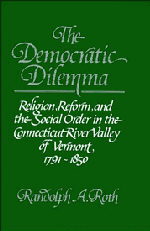 The Democratic Dilemma
The Democratic Dilemma Book contents
- Frontmatter
- Contents
- List of tables and maps
- Acknowledgments
- Introduction
- 1 The revolutionary frontier, 1763–1800
- 2 The failure of the covenanted community and the standing order, 1791–1815
- 3 Religion and reform in the shaping of a new order, 1815–1828
- 4 From an era of promise to pressing times, 1815–1843
- 5 A clamor for reform, 1828–1835
- 6 The great revival, 1827–1843
- 7 A modified order in town life and politics, 1835–1850
- 8 Boosterism, sentiment, free soil, and the preservation of a Christian, reformed republic
- Conclusion: Religion, reform, and the problem of order in the Age of Democratic Revolution
- Appendix A Church records
- Appendix B Types of towns
- Appendix C Occupational groups
- Appendix D Statistical methods
- Notes
- Index
7 - A modified order in town life and politics, 1835–1850
Published online by Cambridge University Press: 04 August 2010
- Frontmatter
- Contents
- List of tables and maps
- Acknowledgments
- Introduction
- 1 The revolutionary frontier, 1763–1800
- 2 The failure of the covenanted community and the standing order, 1791–1815
- 3 Religion and reform in the shaping of a new order, 1815–1828
- 4 From an era of promise to pressing times, 1815–1843
- 5 A clamor for reform, 1828–1835
- 6 The great revival, 1827–1843
- 7 A modified order in town life and politics, 1835–1850
- 8 Boosterism, sentiment, free soil, and the preservation of a Christian, reformed republic
- Conclusion: Religion, reform, and the problem of order in the Age of Democratic Revolution
- Appendix A Church records
- Appendix B Types of towns
- Appendix C Occupational groups
- Appendix D Statistical methods
- Notes
- Index
Summary
Adding to the difficulties posed by the political impasse in the valley, the sharp divisions among reformers, and the crisis of confidence in the revival, a serious recession struck Vermont in 1837 and did not abate until 1843. Financiers and entrepreneurs were stymied. Financial institutions struggled to stay afloat. The largest bank in the valley, the Bank of Windsor, went into bankruptcy in 1838; the smallest, the Bank of Guildhall, followed suit in 1839. Incorporation petitions dropped off drastically for want of capital and ready markets for manufactured goods. Thirty-five woolen mills had incorporated in the valley between 1834 and 1836, but none incorporated between 1837 and 1843. No machinery firms were incorporated either, and plans drawn up at a rail convention in Windsor in 1836 to crisscross the valley with railroads were set aside. All types of construction lagged, and carpenters and day laborers were thrown out of work.
In the countryside, mechanics and farmers felt the pinch of a drop in urban demand for their goods and produce. Faltering demand for woolen goods and ready-made apparel drove a number of rural master craftsmen engaged in wool processing, tanning, shoemaking, hat making, and tailoring out of business. Women and children employed by woolen mills or on the putting out system in these crafts found fewer opportunities to add to the family income. The drop in demand hurt farmers, who lost almost a quarter of their purchasing power between 1839 and 1843 because their wool and hides were no longer wanted, and rural mechanics, who could find few farmers willing to buy their furniture, wagons, and plows.
- Type
- Chapter
- Information
- The Democratic DilemmaReligion, Reform, and the Social Order in the Connecticut River Valley of Vermont, 1791–1850, pp. 220 - 264Publisher: Cambridge University PressPrint publication year: 1987


